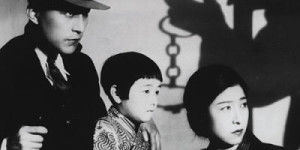STUDIO: Eclipse/Criterion | DIRECTOR: Yasujiro Ozu | CAST: Minoru Takada, Hiroko Kawasaki, Tokihiko Okada, Emiko Yagumo, Joji Oka, Kinuyo Tanaka
RELEASE DATE: 4/21/15 | PRICE: DVD $44.95
BONUSES: notes by Michael Koresky
SPECS: NR | 261 min. | Foreign crime dramas | 1.33:1 fullscreen | monoRATINGS (out of 5 dishes): Movie
| Audio
| Video
| Overall
Yasujiro Ozu (Tokyo Story) has long been considered one of the cinema’s true masters, a filmmaker for whom understatement and subtlety were prime virtues. It’s thus fascinating to watch Silent Ozu: Three Crime Dramas, films from an earlier stage of his career when he worked in several genres, including the rarely understated (and seldom subtle) gangster picture.
The films’ visual style is very different from Ozu’s later fixed, “still life” approach — here the cameras move a great deal, the crime sequences are shot in mostly dark locations and the editing is quite lively. The notes in the box set by Michael Koresky mention von Sternberg as an influence; this is true, but one can be certain that Ozu had also seen the German Expressionist films and Hawks’ hyper-kinetic Scarface.
While these films are more overwrought than Ozu’s later work, they do share with them one dominant theme: the family as the locus point of emotional activity. The characters here are hardened toughs and aspiring hoodlums, but they are continually brought down to Earth by their encounters with their family (or the families of their pals or objects of desire).
All the films in this collection start out in the crime genre and quickly turn into melodrama. The first, Walk Cheerfully (1930), is a classically told tale of a suave gangster (Minoru Takada) who wants to go straight to win the heart of a “good girl” (who wears traditional Japanese garb; the “bad girls” in these pictures wear Western clothing).
The most striking thing about the film, besides the wonderfully sketched milieu of the gangsters, is the comic tone that accompanies certain characters’ appearances onscreen (the gangsters here have Cagney’s loose-limbed dance moves — before Jimmy himself used them on film).
The shortest of the films, That Night’s Wife (1930), beautifully shows off Ozu’s true mastery of silent cinema (Japan kept making silent films for a few years after the U.S. had converted entirely to production of talkies). A man (Tokihiko Okada) robs a government office and returns to his apartment, where we discover that he committed the crime to pay for medical care for his sick daughter.
Most of the film takes place in the thief’s apartment, as his wife (Emiko Yagumo) holds a policeman at bay with a gun. The film is thus pretty much a filmed play, but the reliance on images to tell the story (intertitles are used, but sparingly) makes the film a very “pure” silent film in the mode of Murnau.
Dragnet Girl (1933), the third feature, prefigures the later Ozu classics in its concentration on the living spaces and offices inhabited by the characters. It is the liveliest of the three films as well, featuring a “crisis of conscience” suffered by a gangster (Joji Oka) and his moll (Kinuyo Tanaka). Influenced by a good girl (again, wearing traditional Japanese clothing), the gangster and his fashionable girlfriend (who wears saucy western outfits) decide to pull “one last job” to pay the debts of a young boxer who needs their help.
Dragnet is balanced between crime sequences and heavy melodrama, but it also contains showy moments like the one in which we view a car chase from the back of a headlight on our antihero’s car.
The prints of the films included here are somewhat blotchy and not as pristine as is usually found on Eclipse/Criterion releases. One assumes this was because the films are faded beyond repair in certain sequences. Thankfully, though, the films are complete, and they were not lost, as so many early Ozu features have been.
|
Buy or Rent Eclipse 42: Silent Ozu – Three Crime Dramas
|
|||
|---|---|---|---|
 |
|||

Leave a Reply